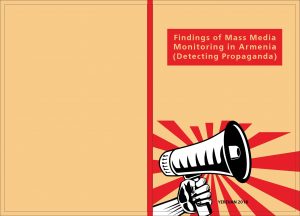by Hasmik Grigoryan, PhD candidate at the School of Law and Government, DCU.
Disinformation in the Media of post-Soviet states
Freedom of Press and lack of fact-based information is one of the important challenges that Armenia faces. In 2016, Freedom House defined the press freedom status of Armenia as not free, stating that government and media owners influence the media content. At the same time, impediment of free speech is not the only problem for post-Soviet Armenia. According to Disinformation Resilience Index 2018, Armenia is scored at 2.2 (out of 4) in terms of population exposure to media led by Russia, where the highest score indicates the larger vulnerability to Kremlin-led disinformation.
According to Fetzer (2004) disinformation includes dissemination of misleading, incomplete or inaccurate information with an intention to distort the truth. As Fallis (2015, pp.404-406) writes disinformation is a type of misleading information that can create false beliefs. Misleading information can be propagated through various channels such as television, magazines and newspapers (Smarandache, Vladutescu and Nicolescu 2014, p.11). Western governments and international organizations have also raised concerns over this issue. With rising tension between Russia and the West, official structures established units that combat against Russian disinformation. For example, in 2015 the European External Action Service East StratCom Task Force launched the “EU versus Disinformation” campaign to respond pro-Kremlin disinformation.
Armenia is one of the post-Soviet countries, that have actively cooperated both with the EU and Russia – National Security Strategy of the Republic of Armenia states that Armenian’s foreign policy is based on complementarity. However, its partnership with the EU has been quite rocky. On September 3, 2013, after his visit to Russia, the president of Armenia unexpectedly announced that Armenia will not sign the negotiated Association Agreement with the EU, but instead will join the Russia-led Customs union. The EU-Armenia active relations restarted several years later when, on November 24, 2017, Armenia signed a new Comprehensive and Enhanced Partnership Agreement (CEPA) with the EU.
In light of low freedom and exposure to disinformation in the region, how have Russian and Armenian media covered the EU-Armenia relations? Can we see disinformation reflected in the press when Armenia signed the CEPA agreement with the EU?
Coverage about the West in Russian and Armenian Media
In October-December 2017, Yerevan-based ACGRC carried out monitoring of 3 Russian, 1 Armenian TV channels and 10 printed and online Armenian mass media. According to the report, information about the West and its relations with the post-Soviet countries, presented in Armenian and Russian media, often resembled disinformation.
Russian TV channels frequently covered broad international topics related to the West, Syria, Ukraine and Iraq, and relations of the post-Soviet states with the EU. When presenting the news about Armenia-EU CEPA agreement, the TV channels stated that former Soviet republics called Russia as their enemy. Often reference was made to case of Ukraine, stating that Ukraine leads a war in its Eastern part of the country, that Ukraine is not an independent state, but all its actions are dictated by the U.S. Information was presented that the U.S. uses the conflict in Ukraine in order to extend sanctions against Russia and prevent the formation of a union between Ukraine and Russia.
We can observe similar repercussions in the Armenian media. Although the coverage and the scope of themes were narrower in this case, Armenian news sources also broadcast or published false information. For instance, we can notice statements in the media that CEPA agreement between the EU and Armenia includes mere detailed instructions to dictate how Armenia should act, that the EU signed the agreement with Armenia only for self-interests to raise its authority in the region. Attempts have been made to spread information that the EU is a failed project.
When analyzing the impact of EU-Armenia agreement on the country, Armenian media wrote that the EU strives to destroy Armenian identity, that the Russia-led Eurasian Economic Union is a security guarantee of Armenia. Another important concern is that often internal issues of Armenia were connected with the role of the EU. For example, the adoption of law against domestic violence in Armenia was frequently mentioned in the media, stating that the EU strives to undermine national values in the country by making Armenia to adopt the law against domestic violence.
Armenian media also made comparison with other post-Soviet countries such as Moldova and Ukraine that signed the extensive Association Agreement with the EU. The published stories strived to present information that the countries that have signed agreements with the EU faced economic problems and even lost territories. For instance, one could see analysis that the EU and, generally, the West are guilty for making a chaos in Ukraine. Coverage would include statements that the economy of Moldova and Ukraine are ruined, after signing the Association Agreements. It was also mentioned that Ukraine strives to fight against Russia. And that European Union is guided by dual standards.
When observing media in Armenia, we need to keep in mind that post-Soviet countries may frequently be exposed to disinformation. It is disturbing that citizens often may perceive false information as everyday news. It is important to be vigilant and be able to distinguish between alternative news and disinformation, as disinformation may hinder politicians and population to make free choices in their foreign and domestic policies.
References:
Fetzer, J.H. 2004. Information: Does it Have To Be True? Minds and Machines, 14(2), pp.223–229.
Fallis, D. 2015. What Is Disinformation? Library Trends, 63(3), pp.401–426.
Smarandache, F., Vladutescu S. and Nicolescu, A. 2014. Disinformation as an Intentional and
Legal Failure of Communication. IN: Smarandache, F., Vladutescu S. and Tenescu A. (eds). Current Communication Difficulties. Craiova: Editura SITECH, pp. 9-26.


